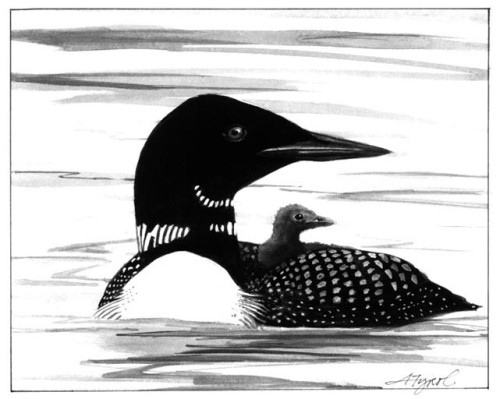Some now call it “The Great Loon Die-off of 1983,” in which nearly 10,000 common loons washed up on the northern shores of the Gulf of Mexico from Florida to Texas. Those found alive were emaciated, anemic, full of parasites, loaded with toxic mercury from a fish diet, and they didn’t have the strength or coordination to survive. Exactly what triggered their deaths is still a mystery. More than 1,000 miles away, in the Northeast, wildlife biologists grew concerned.
Scientists here assumed many of those dead and dying loons were Northeastern residents that had migrated to the Gulf region for winter. They would not be returning, which would further deplete populations in northern New England.
In Vermont, that same year, the loon population dipped to just seven breeding pair, the lowest number recorded. “We suspected that some Vermont birds were among the casualties from this massive mortality,” says Chris Rimmer, co-director of the Vermont Loon Recovery Project, a partnership between the state and conservations groups. “This was a real conservation concern for us.”
Vermont’s loon population had been dropping off dramatically even before the Gulf die-off. Loons in Vermont were disappearing because of nest-site disturbances by humans and animal predators, flooding from dams, habitat loss from development, and mercury and lead contamination. The die-off in the Gulf was one more reason to sound alarms.
Just before the Gulf die-off, the Loon Recovery Project had begun working with lakeshore owners, dam operators, lake associations and various government agencies to help save the birds. Wildlife officials soon began doing a better job monitoring loon populations, improving their habitats and telling the public how they might help.
In New Hampshire, during the mid 1980s, the number of breeding loons was actually on a slow rise, which might have suggested that loon mortality in the Gulf was not affecting northern New England populations. New Hampshire at the time had 10 times as many breeding pairs as Vermont.
Still, efforts at saving loons intensified in both states. By 1990 scientists reported a significant upturn in populations. A milestone was reached in Vermont in 2005 when, after nearly two decades, loons were removed from the state’s Endangered Species List. This year, Vermont recorded 66 pairs of loons and New Hampshire more than 300.
This increase in the two states is hailed as a conservation success story. But until recently scientists here still have been concerned about what fate might await our loons at their winter homes. To what extent, if any, did that ’83 die-off in the Gulf affect our loons. And do the loons of Northern New England still face unusual risk, even catastrophe, where they winter?
In fact, when bird experts here expressed concern two decades ago about winter habitat, they did not know where loons from our region spent the cold months.
Enter a team of biologists from the Upper Midwest Environmental Science Center, the New York State Department of Environmental Conservation, the Wildlife Society, the BioDiverisity Research Institute in Maine, FPL Energy Maine Hydro and the U.S. Fish and Wildlife Service.
From 2003 to 2005 the team captured 17 loons in New York, New Hampshire and Maine. The biologists used a boat and a powerful spotlight to approach the loons at night as the birds floated on the water. When close enough, the teams would quickly dip a net into the water and bring one of the large birds aboard. At a portable laboratory on shore, birds were anesthetized and received tiny transmitters and battery packs that were surgically implanted under skin on their backs. A thin antenna rose from each bird’s back, and it would send signals tracked by passing weather satellites. The bird locations were transmitted from satellite to computers in France and Maryland.
The biologists were able to follow 10 of the loons from their breeding lakes to the wintering grounds. Where did they go? Most went to the Atlantic Coast. In-flight data showed straight-line flight patterns even when those routes took birds directly over mountains. The birds seemed to ignore easier routes along river valleys. New Hampshire and Maine loons migrated to Maine, while loons from New York wintered from Massachusetts to southern New Jersey.
Another Gulf Coast die-off is unlikely to affect loon populations from our region. The loons that died appear to have been from Midwest states and from Canada’s interior. Loon experts from New York and New England instead now fear East Coast oil spills. In January of 1996, a barge ran aground off the coast of Rhode Island, spilling its cargo of home heating oil. The spill killed more than 400 wintering loons. In April of 2003, a barge struck bottom in Buzzards Bay, off southeastern Massachusetts, spilling its load of fuel oil and killing more than 200 loons.


